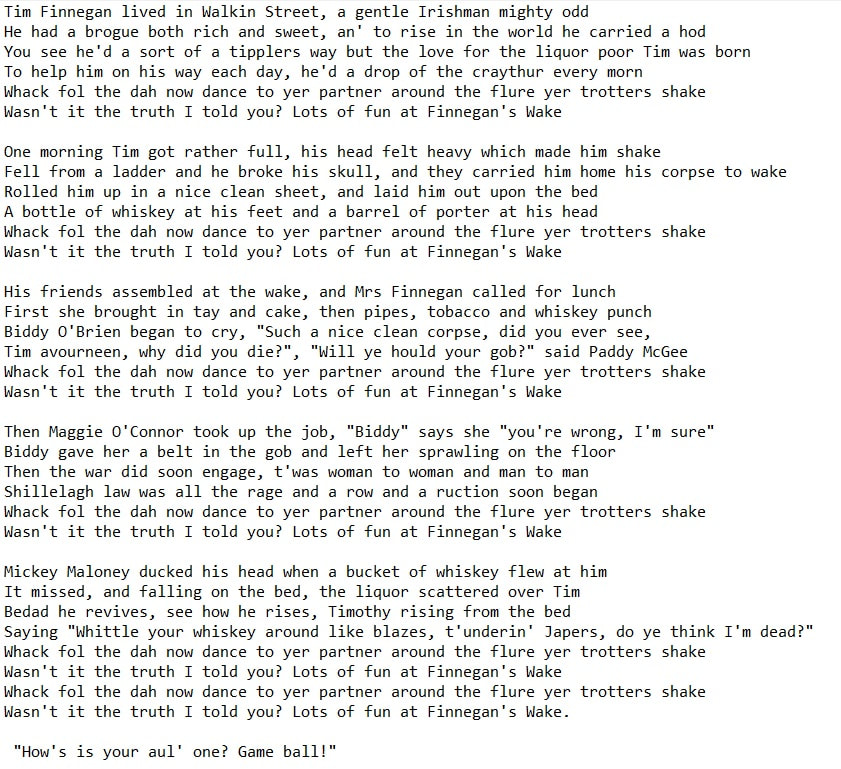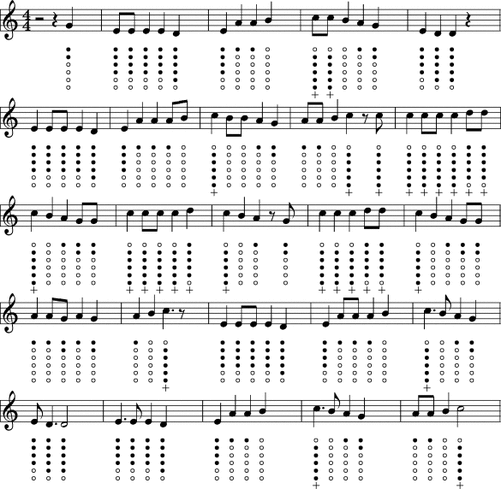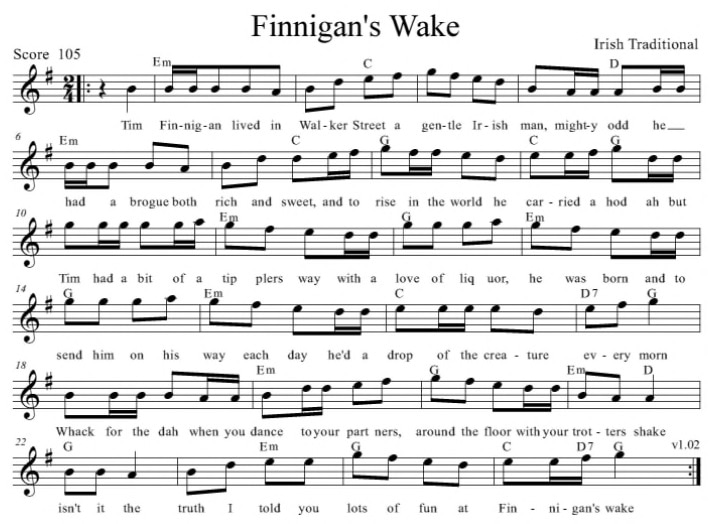Finnegan's Wake lyrics and chords
This a comical Irish song from around 1850s. The guitar chords are in C Major in chordpro. This is the song that James Joyce set his masterpiece ''Finnegans Wake''The song itself was brought back to life by The Dubliners. and later by The Irish Rovers [ lyrics ] and later still by Dropkick Murphys, Seamus Kennedy and The High Kings. Sheet music and tin whistle notes are included. Youtube video by The Dubliners.
|
Tim[C] Finnegan lived in[Am] Walkin Street, a[F] gentle Irishman[G] mighty odd
He[C] had a brogue both[Am] rich and sweet, an' to[F] rise in the [G]world he carried a[C] hod You see he'd a sort of a[Am] tipplers way but the[C] love for the[Am] liquor poor Tim was[C] born To help him on his[Am] way each day, he'd a[F] drop of the[G] craythur every[C] morn [C]Whack fol the dah now[Am] dance to yer[F] partner around the flure yer[G] trotters shake [C]Wasn't it the[Am] truth I told you?[F] Lots of fun at [G]Finnegan's[C] Wake One morning Tim got rather full, his head felt heavy which made him shake Fell from a ladder and he broke his skull, and they carried him home his corpse to wake Rolled him up in a nice clean sheet, and laid him out upon the bed A bottle of whiskey at his feet and a barrel of porter at his head Whack fol the dah now dance to yer partner around the flure yer trotters shake Wasn't it the truth I told you? Lots of fun at Finnegan's Wake His friends assembled at the wake, and Mrs Finnegan called for lunch First she brought in tay and cake, then pipes, tobacco and whiskey punch Biddy O'Brien began to cry, "Such a nice clean corpse, did you ever see, Tim avourneen, why did you die?", "Will ye hould your gob?" said Paddy McGee Whack fol the dah now dance to yer partner around the flure yer trotters shake Wasn't it the truth I told you? Lots of fun at Finnegan's Wake Then Maggie O'Connor took up the job, "Biddy" says she "you're wrong, I'm sure" Biddy gave her a belt in the gob and left her sprawling on the floor Then the war did soon engage, t'was woman to woman and man to man Shillelagh law was all the rage and a row and a ruction soon began Whack fol the dah now dance to yer partner around the flure yer trotters shake Wasn't it the truth I told you? Lots of fun at Finnegan's Wake Mickey Maloney ducked his head when a bucket of whiskey flew at him It missed, and falling on the bed, the liquor scattered over Tim Bedad he revives, see how he rises, Timothy rising from the bed Saying "Whittle your whiskey around like blazes, t'underin' Japers, do ye think I'm dead?" Whack fol the dah now dance to yer partner around the flure yer trotters shake Wasn't it the truth I told you? Lots of fun at Finnegan's Wake Whack fol the dah now dance to yer partner around the flure yer trotters shake Wasn't it the truth I told you? Lots of fun at Finnegan's Wake. “How’s is your aul’ one? Game ball!” ________________________________________ How is your aul one means, How is you mother or wife. Game ball means fine, or good or OK Aul or sometimes spelt ''Auld'' means old. “How’s is your aul’ one? Game ball!” is an old Dublin saying. It's used a lot by ballad singers at the end of a song just as a bit of fun. See slang Irish words . Here's the chords in the key of G.
Tim[G] Finnegan lived in[Em] Walkin Street, a[C] gentle Irishman[D] mighty odd He[G] had a brogue both[Em] rich and sweet, an' to[C] rise in the [D]world he carried a[G] hod You see he'd a sort of a[Em] tipplers way but the[G] love for the[Em] liquor poor Tim was[G] born To help him on his[Em] way each day, he'd a[C] drop of the[D] craythur every[G] morn [G]Whack fol the dah now[Em] dance to yer[C] partner around the flure yer[D] trotters shake [G]Wasn't it the[Em] truth I told you?[C] Lots of fun at [D]Finnegan's[G] Wake |
|
Here's the sheet music for Finnegan's Wake
Finnegans Wake is a novel like no other. Written by James Joyce and published in 1939, it is a complex and experimental work that has confounded readers and scholars alike. It is a book that defies easy categorization, with layers of meaning and symbolism that make it a challenge to decipher. However, at its core, Finnegans Wake is a song – a song that tells the story of humanity, from its origins to its ultimate fate.
The title of the novel itself is a reference to a traditional Irish ballad, 'Finnegan's Wake,' which tells the story of Tim Finnegan, a hard-drinking laborer who falls off a ladder and is believed to be dead. His friends and family gather for his wake, but as they mourn and lament, Finnegan suddenly awakens and joins in the revelry. This song is often seen as a metaphor for the cycle of life and death, and this theme is central to Joyce's novel.
At its most basic level, Finnegans Wake is the story of a Dublin pub owner, HCE, and his family. However, the narrative is far from linear, as it weaves in and out of dreams, memories, and different languages. The language itself is a major aspect of the novel, as Joyce creates a unique, stream-of-consciousness style that is filled with puns, wordplay, and invented words. This language is often referred to as 'Joyce's Wakean' and is seen as a reflection of the chaos and confusion of human experience.
The novel is also deeply rooted in Irish history and mythology. Joyce draws on a wide range of sources, including the ancient Irish epic, the Táin Bó Cúailnge, as well as the writings of Irish poets and folktales. This blending of different cultural and literary influences adds to the richness and complexity of the novel, making it a truly unique work of art.
One of the key themes of Finnegans Wake is the cyclical nature of time and history. This is reflected in the structure of the novel, which begins and ends in the middle of a sentence, suggesting that the story is constantly repeating itself. This cyclical structure is also reflected in the characters, who are often seen as reincarnations of previous characters or mythological figures. This idea of eternal recurrence is a central concept in many world religions and philosophies, and Joyce captures it in his own unique way through the form of a song.
The novel also explores the idea of the collective unconscious, a concept developed by psychologist Carl Jung. The collective unconscious refers to a shared reservoir of experiences and memories that are inherited from our ancestors and are represented in our dreams and myths. In Finnegans Wake, Joyce delves into this concept through the use of archetypes and recurring symbols. These symbols, such as the letter 'H' and the number '1132,' represent different aspects of the human experience and connect the characters and events in the novel to a larger, universal narrative.
Another important aspect of Finnegans Wake is its exploration of language and its limitations. Joyce plays with words and their meanings, creating a sense of ambiguity and multiple interpretations. He also uses different languages, from English and Irish to Latin and other European languages, to further blur the lines between reality and dream, and to emphasize the idea that language is a construct and can never fully capture the complexity of human experience.
In addition, the novel is deeply autobiographical, as Joyce draws heavily from his own life and experiences. He weaves in references to his family, friends, and the city of Dublin, as well as his own struggles with language and writing. This personal touch adds another layer of depth to the novel and makes it a reflection of Joyce's own life and worldview.
In conclusion, Finnegans Wake is a song that captures the essence of humanity. Through its unique language, cyclical structure, and exploration of universal themes, it tells the story of human existence – from its beginnings to its inevitable end. It is a challenging and thought-provoking work that continues to fascinate and mystify readers, and will likely do so for generations to come. Joyce's masterpiece is a testament to the power of literature to transcend time and place, and to connect us all through the shared experience of being human.
The title of the novel itself is a reference to a traditional Irish ballad, 'Finnegan's Wake,' which tells the story of Tim Finnegan, a hard-drinking laborer who falls off a ladder and is believed to be dead. His friends and family gather for his wake, but as they mourn and lament, Finnegan suddenly awakens and joins in the revelry. This song is often seen as a metaphor for the cycle of life and death, and this theme is central to Joyce's novel.
At its most basic level, Finnegans Wake is the story of a Dublin pub owner, HCE, and his family. However, the narrative is far from linear, as it weaves in and out of dreams, memories, and different languages. The language itself is a major aspect of the novel, as Joyce creates a unique, stream-of-consciousness style that is filled with puns, wordplay, and invented words. This language is often referred to as 'Joyce's Wakean' and is seen as a reflection of the chaos and confusion of human experience.
The novel is also deeply rooted in Irish history and mythology. Joyce draws on a wide range of sources, including the ancient Irish epic, the Táin Bó Cúailnge, as well as the writings of Irish poets and folktales. This blending of different cultural and literary influences adds to the richness and complexity of the novel, making it a truly unique work of art.
One of the key themes of Finnegans Wake is the cyclical nature of time and history. This is reflected in the structure of the novel, which begins and ends in the middle of a sentence, suggesting that the story is constantly repeating itself. This cyclical structure is also reflected in the characters, who are often seen as reincarnations of previous characters or mythological figures. This idea of eternal recurrence is a central concept in many world religions and philosophies, and Joyce captures it in his own unique way through the form of a song.
The novel also explores the idea of the collective unconscious, a concept developed by psychologist Carl Jung. The collective unconscious refers to a shared reservoir of experiences and memories that are inherited from our ancestors and are represented in our dreams and myths. In Finnegans Wake, Joyce delves into this concept through the use of archetypes and recurring symbols. These symbols, such as the letter 'H' and the number '1132,' represent different aspects of the human experience and connect the characters and events in the novel to a larger, universal narrative.
Another important aspect of Finnegans Wake is its exploration of language and its limitations. Joyce plays with words and their meanings, creating a sense of ambiguity and multiple interpretations. He also uses different languages, from English and Irish to Latin and other European languages, to further blur the lines between reality and dream, and to emphasize the idea that language is a construct and can never fully capture the complexity of human experience.
In addition, the novel is deeply autobiographical, as Joyce draws heavily from his own life and experiences. He weaves in references to his family, friends, and the city of Dublin, as well as his own struggles with language and writing. This personal touch adds another layer of depth to the novel and makes it a reflection of Joyce's own life and worldview.
In conclusion, Finnegans Wake is a song that captures the essence of humanity. Through its unique language, cyclical structure, and exploration of universal themes, it tells the story of human existence – from its beginnings to its inevitable end. It is a challenging and thought-provoking work that continues to fascinate and mystify readers, and will likely do so for generations to come. Joyce's masterpiece is a testament to the power of literature to transcend time and place, and to connect us all through the shared experience of being human.




